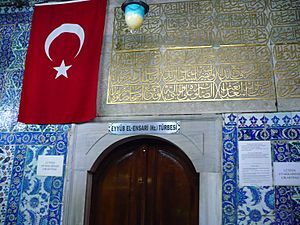Abu Ayyub al-Ansari facts for kids
Quick facts for kids
Abu Ayyub al-Ansari
أبو أيوب الأنصاري |
|
|---|---|

|
|
| Rashidun governor of Medina | |
| Governor | Ali ibn Abi Talib |
| Preceded by | Sahl ibn Hunaif (From 657) |
| Succeeded by | Marwan ibn al-Hakam (662–669) |
| Personal details | |
| Born | Yathrib, Hejaz, Arabia |
| Died | c. 674 Constantinople, Byzantine Empire |
| Relations | Banu Khazraj (Banu Najjar) |
| Parents |
|
Abu Ayyub al-Ansari (Arabic: أبو أيوب الأنصاري, Turkish: Ebu Eyyûb el-Ensarî) was a very close friend and supporter of the Islamic prophet Muhammad. He was born in Yathrib and his real name was Khalid bin Zayd.
Abu Ayyub was part of a group called the Ansar. This Arabic word means "helpers" or "supporters." The Ansar were people in Medina who helped Muhammad after he moved there in 622. This move is known as the Hijra. The name Abu Ayyub means "father of Ayyub." Abu Ayyub passed away around the year 674 during a battle near Constantinople.
Contents
About Abu Ayyub
Abu Ayyub was born in Medina, a city in the Hejaz region. His family was part of the Banu Najjar tribe. He was a respected leader in his family.
Abu Ayyub was one of the first people in Medina to accept Islam. He met Muhammad in a valley called Aqaba. There, he promised to follow Islam and support Muhammad. Muhammad then gave him the name Abu Ayyub al-Ansari.
Muhammad's Arrival in Medina
When Muhammad arrived in Medina, many people wanted him to stay at their house. Muhammad decided to let his camel choose. He said he would stay wherever the camel stopped.
The camel stopped at the house of Abu Ayyub al-Ansari. Abu Ayyub was very happy to host Muhammad. He prepared a meal for Muhammad and his close friend, Abu Bakr. But Muhammad asked him to invite everyone in the neighborhood.
About 180 people came to eat. Everyone was surprised because there was enough food for all of them! People believed this was a miracle.
Building the Prophet's Mosque
Abu Ayyub also played an important role in building Al-Masjid an-Nabawi, which is the Prophet's Mosque. The land for the mosque belonged to two young orphans. They wanted to give the land to Muhammad as a gift.
However, Muhammad insisted on paying for the land. He wanted to be fair, especially since the owners were orphans. Abu Ayyub al-Ansari paid the price for the land. This made him the waqif (donor) of the land for the mosque.
Later, Abu Ayyub was chosen to be the governor of Medina. This happened during the time of Caliph Ali ibn Abi Talib.
Life in Egypt
After Muslims conquered Egypt, Abu Ayyub moved there. He lived in a city called Fustat. His house was next to a mosque built in 642. Many other important companions of Muhammad lived nearby.
Abu Ayyub was also a brave soldier. People said he joined almost every battle the Muslims fought. He was always ready to serve.
His Last Battle
Abu Ayyub joined a big military campaign against the Byzantine Empire. This was the First Arab Siege of Constantinople. Even though he was an old man, he wanted to fight.
During the battle, he became very ill. The army leader, Yazid ibn Muawiya, asked him if he needed anything. Abu Ayyub replied, "Give my greetings to the Muslim armies." He also asked them to carry him deep into enemy land. He wanted to be buried right at the walls of Constantinople.
Abu Ayyub passed away soon after. The army followed his wish. They pushed back the enemy and buried him near the city walls.
A story from this battle tells us about bravery. A Muslim soldier charged deep into the enemy lines. Some people worried he was putting himself in danger. But Abu Ayyub explained that true danger was avoiding battle. He said that staying home with wealth instead of fighting for Islam was the real destruction.
His Mosque and Tomb
After the Ottoman Turks conquered Constantinople, they honored Abu Ayyub. Sultan Mehmed the Conqueror built a tomb over his grave. A mosque was also built in his honor.
This area, now called Eyüp, became a very special place. Many Ottoman leaders wanted to be buried near Abu Ayyub's tomb. His tomb was rediscovered by a saint named Akşemseddin. The tomb was rebuilt in 1882.
The Eyüp Sultan Mosque became a traditional place for Ottoman Sultans to be crowned. Each new Sultan would receive the Sword of Osman there.
Sayings Narrated by Abu Ayyub
Abu Ayyub al-Ansari shared many sayings of Muhammad. Here are a few examples:
- Muhammad said: "It is not right for a Muslim to avoid speaking to another Muslim for more than three nights. When they meet, one turns away from the other. The best of them is the one who greets the other first."
- Abu Ayyub al-Ansari also shared a story about the night of Mi'raj (Muhammad's miraculous journey). Muhammad met Abraham. Abraham asked, "O Jibreel, who is with you?" Jibreel replied, "Muhammad." Abraham then told Muhammad, "Tell your followers to plant many trees in Paradise. The soil of Paradise is good, and its land is vast." When asked what the trees of Paradise were, he replied, "La hawla wa la quwwata illa billah" (meaning "There is no power or strength except with Allah").

